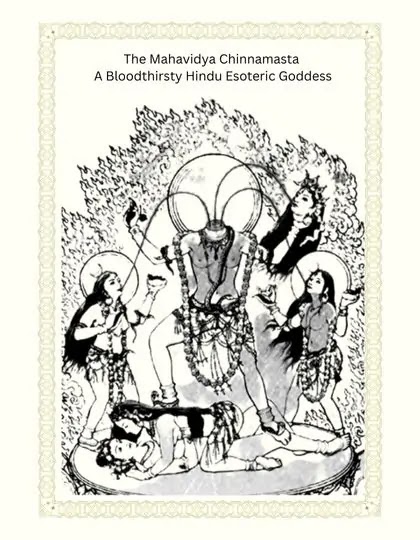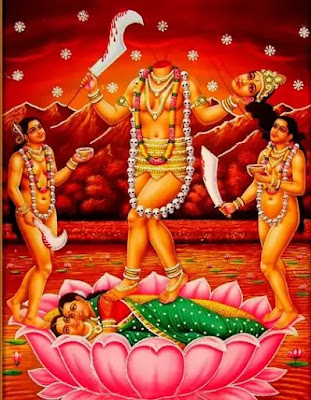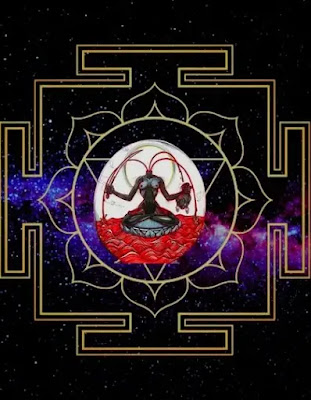A Bloodthirsty Hindu Esoteric Goddess Devi Chinnamasta
Chinnamasta is a ferocious aspect of Devi Parvati, the Hindu Divine Mother, and one of the Mahavidyas of the ten Tantric goddesses. Chinnamasta is made up of two words: Chinna and Masta. The terms Chinna and Masta indicate "disconnected" and "the head," in both. As a result, The Mahavidya translates as "the one with a decapitated head." She is also known as Chhinnamastika, Prachanda Chandika, and Jogani Maa.
The Iconography of Goddess Prachanda Chandika
Chinnamasta Devi has separated her own head with her own weapon and is keeping her bloody head in one hand. Three streams of blood surge from her spurting blood neck, one straight into the mouth of her split head, another two into the mouths of her two female collaborators, Dakini and Varnini. The Goddess is frequently depicted naked and with messy hair, stepping on the bodies of Kama and his wife Rati. As a result, Bloodthirsty Devi is said to be as red as a hibiscus flower. Her left foot is placed to indicate that she is prepared to move or is constantly in motion. She also has a knife in her hand, in addition to the decapitated head. She wears a rattlesnake around her neck and has three eyes. Even after her frightening appearance, she is considered Satvik as well as very feminine.
Two distinct explanations of Maa Chinnamasta's iconography One interpretation sees it as an emblem of sexual arousal control, while another sees it as a symbol of the goddess's representation of horniness. Willingness is one of the primary reasons for the external universe's incarnation, which is only possible through the power of the Maha Shakti/Maha Devi. Similar to how a deity seated on a blossom is said to acquire the attributes of harmony and balance and simplicity, Kamadeva and Rati pass on the strength and energy derived from their copulation to the Goddess standing over them. This power generation, which is part of a multidisciplinary up through her body, utters out of her headless chest area to serve her worshippers while also replacing herself. As the Shakti or strength of the Trimurti and the energy behind everything that plays a role in the spiritual realm, the mother who is the physiological multiverse sets up, preserves, and destroys it. The Mother's formation seems to become her snack as well, which is also very much related to blood sacrifice, which is involved in some Shakti/Mother Goddess worship because it is the offering of life energy back to her so that the energy can be used again and used for other creative purposes.
Mahavidya Chhinnamastika Devi's Appearance
According to Pranatoshini Tantra, Goddess Parvati went to the Mandakini River for a bath one day with her two attendants Dakini and Varnini. But, for some obscure reason, she became sexually assaulted while taking a bath and turned black. During the same time, two of her companions became tired and hungry and requested food from her. She couldn't say no to them because she was the mother of the world, so she severed her head with a cutlass and put it in the palm of her left hand. Three levels of blood arose from her neck. One force reached her mouth, and two others managed to enter the mouths of her companions. She then attached her head to her body and arrived home. This is a metaphoric story about Kundalini's awakening. Many things in Tantra are represented by blood, sex, wine, and so on.
As per Svatantra, when Lord Shiva and Goddess Chandika were copulating in reverse poses, she had already become enraged during groundbreaking combustion, and Dakini and Varnini rose from her body. The remainder of the story is identical to that of Pranatoshini Tantra. Lord Shiva discovered her pale upon her return from bathing. This enraged him, and he took the form of Krodha Bhairava. Viraratri is the day of the goddess's birth.
Devi Chinnamasta Temple
The temple in Chintpurni, Himachal Pradesh, claims to be one of the Shakti Peeths and the location where the goddess Sati's forehead fell. Chhinnamastika is interpreted as both the severed-headed and the foreheaded one in this context. She has a shrine in Ramnagar, near Varanasi, where Tantrik worships her with corpses. In Jharkhand, there are Devi shrines on the hill Nandan Parvat near Deoghar and in Ranchi, as well as other Mahavidyas. Her shrine, along with other Mahavidyas, is located in Assam's Kamakhya Temple complex. In Bishnupur, West Bengal, there is a temple dedicated to her. The shrines of Chhinnamastika can also be found in Nepal's Kathmandu Valley, most notably near the Changu Narayan temple.
Chinnamasta Devi Yantra, Tantra, Mantra
Jogani Maa's shaved head symbolizes awareness liberated from the possible constraints of the human body and mind, whereas her thunder hair and radiant eyes represent a straightforward impression of God's Pure Awareness. The weapon she holds in her left hand represents wisdom, and the goddess' tongue represents the massive authority of the spiritual emblems, or mantras, as her sculpture is difficult to render.
Devi Chinnamasta Yantra: The Yantra assists in breaking free from mental restrictions, supporting effective meditation, and getting a better impression. It also aids in breaking free from difficulties and finding solutions to problems. The above yantra helps to reduce negative or dark energies. It produces energy and confidence to complete all tasks against all probability and achieve success in every position you hold.
The goddess represents cosmic consciousness and kundalini awakening; divine power. Jogani Maa legends focus on her ego, which is sometimes combined with a nurturing element, associated with sex supremacy, and conscience rage. Jogani Maa is a goddess of paradoxes. She represents two very different sides of Devi: a life-giver and a life-taker. Depending on how she is interpreted, she is both a symbol of sexual self-control and an embodiment of sexual energy. She denotes both life, eternal life, and entertainment, as well as death, temporality, and destruction.
Chinnamasta Devi Mantra: Chinnamunda is a major Tantric divinity that is respected and revered by esoteric Tantric practitioners. Chinnamunda, the severed-headed form of the Tibetan Buddhist goddess Vajrayogini, is related to Maa Chinnamasta. Her powerful six mantras are given below:
Ekakshara Mantra
हूं॥
Hum॥
Tryakshar Mantra
ॐ हूं ॐ॥
Om Hum Om॥
Chaturakshar Mantra
ॐ हूं स्वाहा॥
Om Hum Svaha॥
Panchakshar Mantra
ॐ हूं स्वाहा ॐ॥
Om Hum Svaha Om॥
Shadakshar Mantra
ह्रीं क्लीं श्रीं ऐं हूं फट्॥
Hreem Kleem Shreem Aim Hum Phat॥
Gayatri Mantra
ॐ वैरोचन्ये विद्महे छिन्नमस्तायै धीमहि तन्नो देवी प्रचोदयात्॥
Om Vairochanye Vidmahe Chinnamastayai Dhimahi Tanno Devi Prachodayat॥
How To Chant Chinnamasta Mantra?
Goddess Chhinnamasta is satisfied by chanting mantras, performing adoration either in her image or with the help of special Yantras made for the Goddess worship, and by following certain practices and offering requirements. Once the goddess is satisfied with you, all of your desires are fulfilled. Devi grants you unbreakable supernatural religious practices and methods, as well as economic affluence.
The devotee should then visualize Prachanda Chandika in his or her mind.
The mantra should be chanted early in the morning, around 12:13 a.m. Tuesday or Friday are ideal days to begin.
Those who chant the mantra should bathe and dress in blue.
The individual should sit facing north and light a mustard oil lamp, Provide a dark-colored fruit and a blue-colored flower, Wear a red Chandan and light blue flower Agarbatti or use a blue flower fragrance.
Then 108 times repeat the mantra.
Smear kumkum on a coconut and make a black dot on it
From then on, chant the mantra just before sunrise without performing any puja.
After your wish is granted, you must plant five coconut trees.
Benefits of Chinnamasta Devi Mantra:
Protects against all evil, mishaps, diseases, and sorrows.
opens the way to abundance
Ensures spiritual as well as material success.
Assists with Kundalini awakening and Chakra balancing.
Obstacles in life are removed, and stuck processes are accelerated.
Aids in the development of Siddhis.
It aids in the control of excessive sexual desires while also improving sexual expression and performance.
The meditation is deepened.
It bestows supreme knowledge and higher wisdom.
Provides immediate results, and your efforts begin to materialize easily and automatically.
She cleanses the stains of all sins. She is said to undo the wrongdoings of seven births.
She offers refuge to those who are suffering as a result of the wrongdoings of others.
She provides a blank slate for the devotee to start over in life.
Chinnamasta Devi is a splendid supporter who acknowledges and rewards genuine devotion. She can protect and bestow worshippers with all her soul once she is pleased. She can assist people in conquering issues such as poverty, debt, bad fortune, infertility, psychiatric conditions, and unexpected death, as well as guarding them against the ill effects of the planet Rahu. She can also entrust wisdom, achievement, wellness, and affluence, as well as a feeling of happiness in life.
Chinnamasta Devi is a unique Hindu tantric goddess whose tremendous iconography is instantly recognizable by most Hindus. This goddess is associated with recurring regeneration, celestial stability, nourishment, and subconsciousness. Despite these admirable attributes, her impact on Hinduism is confined to her fierce essence and more extreme worship ceremonies.



